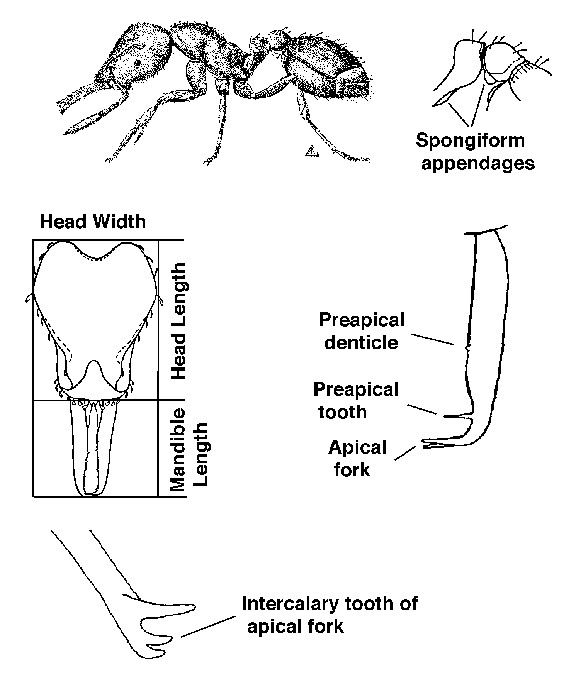
| Genus List | Species List |
For an overview of the Dacetini in Costa Rica, see Pyramica.
This key relies almost entirely on the key in Brown (1962). Also see the restructuring of dacetine genera by Bolton (1999) and the new key to Neotropical species of Strumigenys in Bolton (2000). A few elements of Bolton's new key have been incorporated here. The figures below illustrate the habitus of Strumigenys, and some of the main characters used in species-level identifications. Measurements are:
HL: head length; maximum length of head as seen from dorsal full-face view, including all of clypeus and vertex lobes, but not mandibles.
HW: head width; maximum width of head in same view as HL.
ML: mandible length; exposed length of mandibles, including apical teeth, measured in same view from which HL is obtained.
CI: cephalic index; 100xHW/HL.
MI: mandibulo-cephalic index; 100xML/HL.

1a. Antenna 4-segmented: emmae
1b. Antenna 6-segmented: 5
5a. Apical fork of mandible without distinct intercalary teeth or denticles (intercalary teeth can be difficult to see; select specimen in which the tips of the mandibles are somewhat separated and tilt specimen to anterior view of mandibles; backlighting often helps) : 10
5b. Apical fork of mandible with one or more intercalary denticles (several common species have the apical fork relatively small, with two tiny intercalary denticles that are difficult to see; often the mandibles are closed on specimens, and the intercalary denticles impossible to see): 500

10a. Mandible without preapical teeth or denticles: 20
10b. Mandible with 1 or 2 preapical teeth and/or denticles: 250
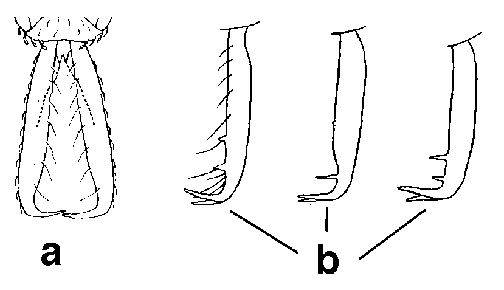
20a. Postpetiole large and convex, its dorsum smooth and shining; setae on gaster straight; larger, more robust species: consanii
20b. Postpetiole small, its dorsum densely punctulate and opaque; setae on gaster flagelliform, bent, coachwhip-like; smaller, more slender species: 100
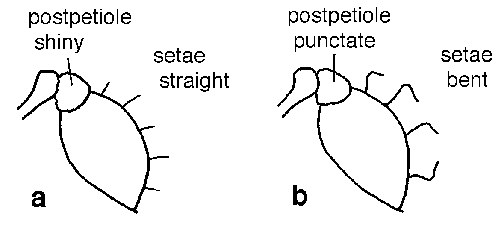
100a. Setae on dorsum of gaster relatively shorter, stouter; propodeal spines relatively larger: pariensis
100b. Setae on dorsum of gaster relatively longer, thinner; propodeal spines relatively smaller: elongata
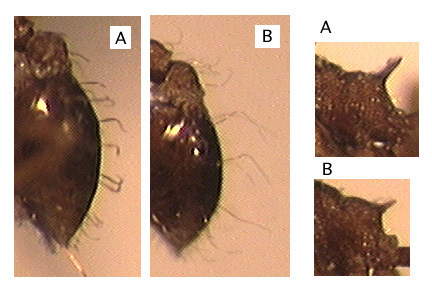
250a. First segment of gaster margined for its full length on each side by a strong, raised dorsolateral ridge: marginiventris
250b. First gastral segment smoothly rounded dorsolaterally, without raised margins apart from the basal costulae: 370
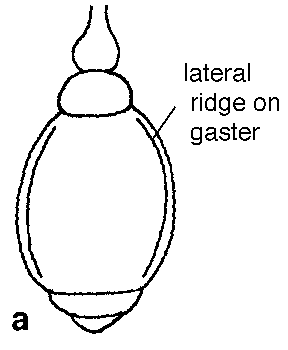
370a. Head with a strong concavity anterior to each eye, and thus appearing constricted in full-face view; humeral tubercles large and produced: precava (keys twice due to variability in intercalary teeth)
370b. Head parallel-sided or gently tapered in front of eyes; humeral tubercles or angles small, not produced: 375


375b. Smaller species with mandibles not so long; combined length of head + mandibles < 1.10mm: 438
438a. Compound eye anteriorly detached, i.e., bounded in front by a narrow cleft or notch in the ventrolateral margin of the head: rogeri
438b. No preocular notch in ventrolateral border of head: 440

440a. Leading edge of scape at the subbasal bend with a lamella; spiniform preapical tooth of mandible occurs about midway between the apicodorsal tooth and the proximal denticle: nastata
440b. Leading edge of scape at the subbasal bend lacks a lamella; spiniform preapical tooth of mandible occurs closer to the apicodorsal tooth than to the proximal denticle: 445
445a. Erect setae on gastral dorsum spatulate: calamita
445b. Erect setae on gastral dorsum filiform: perdita
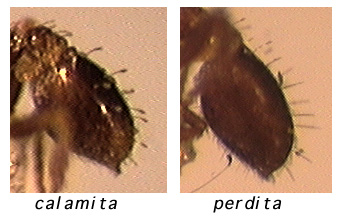
500a. Apical fork of mandible with a single intercalary tooth or denticle, either separate or occurring as a spur on the inner side of the ventral tooth: 510
500b. Apical fork of mandible with 2 intercalary denticles: 750
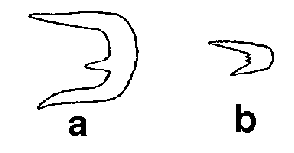
510a. Mandible with no preapical teeth, or with a single preapical tooth or denticle, or with a preapical tooth or denticle plus another minute denticle proximal to it: 520
510b. Mandible with 2 well-developed preapical teeth: 635
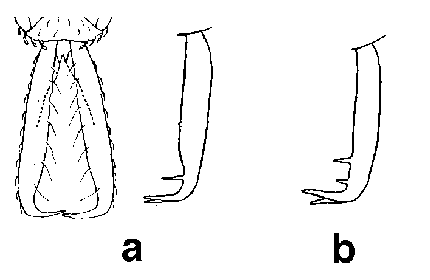
520a. Mandible without preapical teeth or denticles: 530
520b. Mandible with a preapical tooth or denticle, or both: 570

530a. Petiole claviform, the node only feebly differentiated from its anterior peduncle; gastral hairs mostly stiff, spatulate: ludia
530b. Petiolar node with a distinct anterior face, set off from its anterior peduncle; gastral hairs either stiff but filiform, or long, finely flagelliform, coachwhip-like: 554

554a. Erect gastral hairs stiff, filiform, not coachwhip-like; head relatively wider (CI 82): sevesta
554b. Erect gastral hairs long, finely flagelliform, coachwhip-like; head relatively narrower (CI 71-74): 560


560a. Pronotal dorsum finely reticulate-punctate, usually without any costulate sculpture; but if a few faint costulae occur they are insignificant and obviously secondary to the reticulate-punctate component: micretes (keys twice due to variability in preapical denticles).
560b. Longitudinal or oblique costulation as the main component on the pronotal dorsum; any punctate sculpture that may be present is feeble and very obviously secondary to the costulate component: humata
570a. Face strongly flattened, largely concave, margined laterally by frontal carinae: platyscapa
570b. Face convex: 578
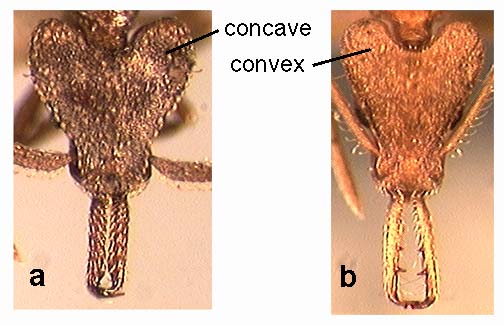
578a. Ventral ends of propodeal lamellae at most rounded or bluntly angulate, not dentiform: 580
578b. Propodeal teeth large and acute, matched on each side below by a metasternal tooth of nearly the same size and shape arising from the ventral end of the infradental lamella: trinidadensis (keys twice due to variability in preapical denticles)

580a. Long fine flagelliform hairs on nodes of petiole and postpetiole and on gastral dorsum very numerous, too many to count: 584
580b. Hairs of nodes and gastral dorsum much fewer, at most about 34 on gastral dorsum, long flagelliform or stiff: 600
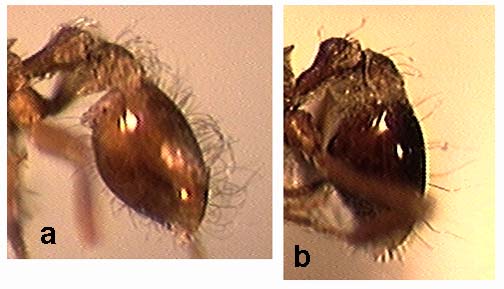
584a. Eye with approximately 20 facets; costae of gaster fine, numerous, variable in extent, from basal 1/4 or less to covering entire surface of first gastral tergum: 590
584b. Eye with fewer than 10 facets; costae of gaster coarse, few, restricted to basal 1/4 or less, rest of gaster smooth and shining: cosmostela
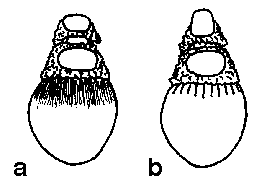
590a. Costae of first gastral tergite extending across entire length; katepisternum and side of propodeum punctate: lanuginosa
590b. Costae of first gastral tergite restricted to basal 1/4, rest of gaster smooth and shining; katepisternum and side of propodeum smooth and shining: JTL-013
600a. Head with a strong concavity anterior to each eye, and thus appearing constricted in full-face view; humeral tubercles large and produced: precava (keys twice due to variability in intercalary teeth)
600b. Head parallel-sided or gently tapered in front of eyes; humeral tubercles or angles small, not produced: 603


603a. Gaster mat, with stiff, clavate setae: idiogenes
603b. Gaster shiny, usually with thin, flagelliform setae: 605
605a. Smaller species, with mandibles < 0.42mm long; head length 0.64mm or less; head broader (CI>75): nevermanni
605b. Larger species, with mandibles 0.42mm or longer; head length 0.69mm or more; head narrower (CI 75 or less): 618

618a. Gastral dorsum with setae stiff, straight, slightly thickened: diaptyxis
618b. Gastral dorsum with setae long, thin, flagelliform: micretes (keys twice due to variability in preapical denticles).

635a. Large species with massive head and short, heavy mandibles (head width > 0.85mm, MI 50 or less): godmani
635b. Smaller species, with more typically proportioned head: 640
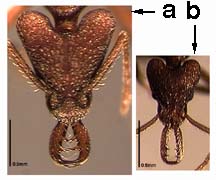
640a. Gastral dorsum finely longitudinally striolate, sericeous-opaque, with very abundant, fine, erect flagelliform pilosity: trinidadensis (keys twice due to variability in preapical denticles)
640b. Gastral dorsum with either sculpture or pilosity or both different from the above: 645
645a. Mandibles longer than the head (MI 109-123): 660
645b. Mandibles shorter than head: 697
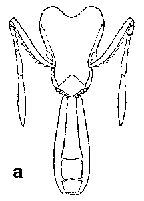
660a. Specialised humeral hair stiff and freely projecting, approx. straight or nearly so, simple or slightly expanded apically; dorsolateral margin of the head close to the apex of the scrobe with stiff projecting hair present: cordovensis
660b. humeral hair short, broadly spatulate, curved posteriorly and closely applied to the surface; dorsolateral margin of the head without stiff projecting hair: deletrix
697a. Propodeal lamellae without dorsal teeth or angles, ventral angle present and prominent; basal costulae on gaster short to absent, less than 0.05mm long along midline: biolleyi
697b. Propodeal lamellae angulate or toothed both above and below; basal costulae on gaster longer, approximately 0.10mm or longer along midline: 725

725a. First gastral tergum with numerous short, strongly spatulate setae; head narrow (CI 65): borgmeieri
725b. First gastral tergum nearly nude, the few scattered setae long and flagelliform; head broader (CI > 80): smithii

750a. Mandible with a single small preapical tooth; no additional preapical teeth or denticles on inner border: louisianae
750b. Mandible with 2 preapical teeth and/or denticles: 885
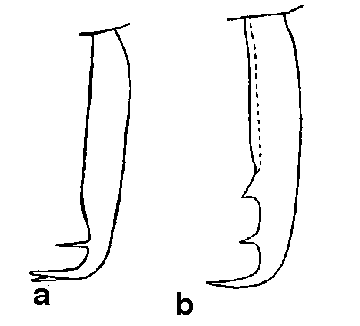
885a. Mandible with 1 preapical tooth and a single additional minute denticle near the apical third of the mandibular length; gastral dorsum with abundant, stiff, erect, spatulate hairs; sculpture of gastral dorsum reticulate-striate, opaque: dubitata
885b. Mandible with 2 well-developed preapical teeth; gastral dorsum with erect hairs, if present, long-flagelliform; sculpture of gastral dorsum variable: 900

900a. First gastral tergite with many long flagelliform hairs, too many to count: cosmostela
900b. First gastral tergite with few or no erect setae: 912
912a. Dorsum of basal gastral segment with longitudinal costulae only at base, otherwise smooth and shining; short, spatulate, reclinate ground hairs of gastral dorsum abundant and conspicuous: extirpa
912b. Dorsum of basal gastral segment longitudinally striolate for its full length; reclinate ground hairs of gastral dorsum obsolete or apparently so: fairchildi
Literature Cited
Bolton, B. 1999. Ant genera of the tribe Dacetonini (Hymenoptera: Formicidae). J. Nat. Hist. 33:1639-1689.
Bolton, B. 2000. The ant tribe Dacetini, with a revision of the Strumigenys species of the Malagasy Region by Brian L. Fisher, and a revision of the Austral epopostrumiform genera by Steven O. Shattuck. Memoirs of the American Entomological Institute 65:1-1028.
Brown, W. L., Jr. 1962. The Neotropical species of the ant genus Strumigenys Fr. Smith: Synopsis and keys to the species. Psyche 69:238-267.
Page author:
John T. Longino, The Evergreen State College, Olympia WA 98505 USA.longinoj@evergreen.edu